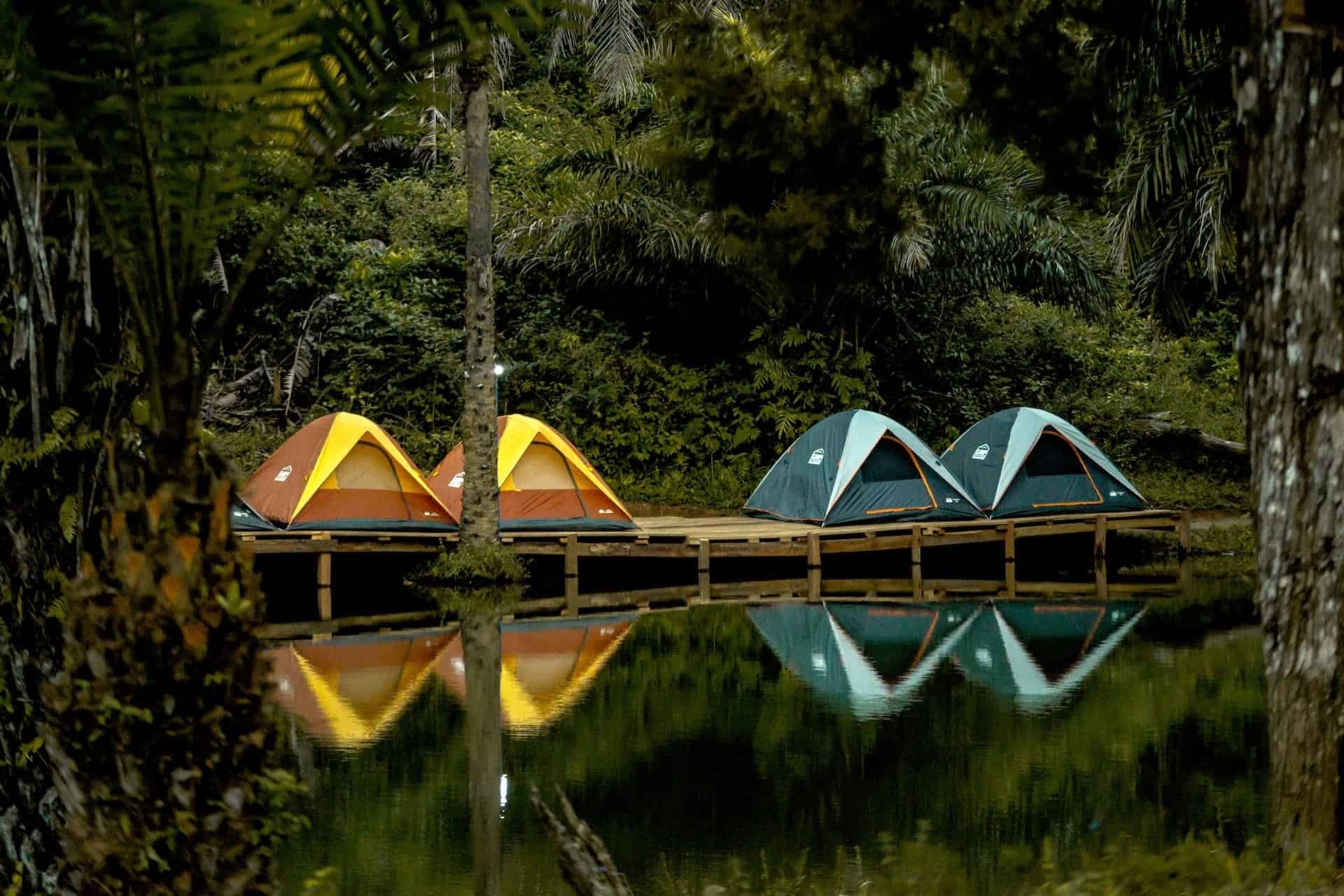There are so many types of camping tents out there, and it’s tough knowing which one is best.
Whether you’re going on a camping trip with your family or a hike through the Andes Mountains, it’s intimidating trying to figure out which tent is right for the job.
Lightweight or double-walled? Multi-room or compact? Blackout or light-filtering? The list goes on.
In this quick guide, we cover the pros and cons of the 16 most common types of tents on the market. We’ve got all your questions covered so you can figure out which types of camping tents are best for you.
Why it’s important to choose the right type of tent

Not all tents are created equal. Different types have different features that make them suited to different environments, so it’s important to choose the right type of tent.
In general, tents are divided into three broad categories:
- Backpacking tents
- Camping tents
- Mountaineering tents
Backpacking tents are made for hiking. They’re lightweight, so they’re easy to carry long distances and compact enough to fit into a backpack.
Camping tents are much heavier and are better for driving straight to a campsite. These are made with comfort in mind, so you wouldn’t want to carry one for miles.
Mountaineering tents are made for high-altitude expeditions. These are single-walled, lightweight, and can withstand high winds and snowfall. If you’re not planning on trekking up a mountain, you probably don’t need a mountaineering tent.
But even though tents generally fall into one of these three categories, there are many more subcategories to choose from.
The first step is figuring out what you want the tent for; then, we can look at the details of the different types of tents.
What are the Types of Camping Tents?
Below are the pros and cons of 16 types of tents, so you can figure out which one is right for your needs.
Tunnel tents
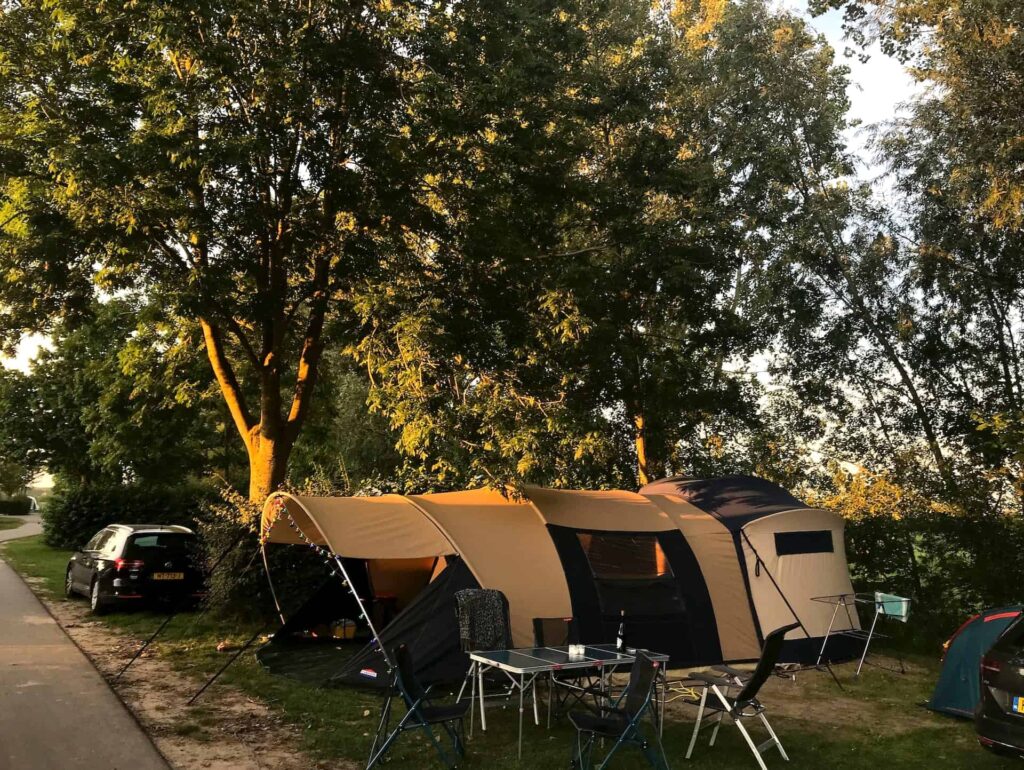
- Ideal for: families and large groups
- Best location: campgrounds
Tunnel tents have a long, cylindrical shape and poles on the exterior of the tent body. On the outside, there are also ropes that can be staked into the ground from attachment points to give better stability.
The main benefit of tunnel tents is the headroom. You can stand upright in most of the interior, and the long shape provides ample living and sleeping space.
The downside of tunnel tents is the weight. They tend to be quite bulky, so they’re not great for backpacking. However, if you’re going on a family camping trip, a tunnel tent is ideal.
Rooftop tents

- Ideal for: individuals and couples
- Best location: roadtrips
These are cabin-shaped tents that attach to the top of vans and other vehicles. They pop up quickly and can be folded away when you need to hit the road.
Most cars have roof bars and can handle a rooftop tent, but make sure your vehicle is suitable before setting one up to go car camping.
Rooftop tents are ideal for road trips and mean you don’t have to sleep in the backseat of your car. It also means you can camp pretty much anywhere – without the need to find a campsite to pitch a tent.
However, car-top tents are compact, with enough room for one or two people max. They’re no good for families and can feel a little claustrophobic.
Inflatable tents
- Ideal for: families
- Best location: campgrounds
Inflatable tents look just like normal tents. The only real difference is that an inflatable tent doesn’t have metal poles. Instead, they have inflatable beams that are pumped up to support the structure.
The key advantage of inflatable tents is speed. Tents with poles can be fiddly and take time to put up and take down. With an inflatable tent, you just attach the pump, and it pretty much erects itself.
The downside is the cost. Inflatable tents are extremely convenient, but they are much more expensive than regular tents. That said, it might be worth it if you’re on a camping trip with kids who get impatient easily.
Canopy tents
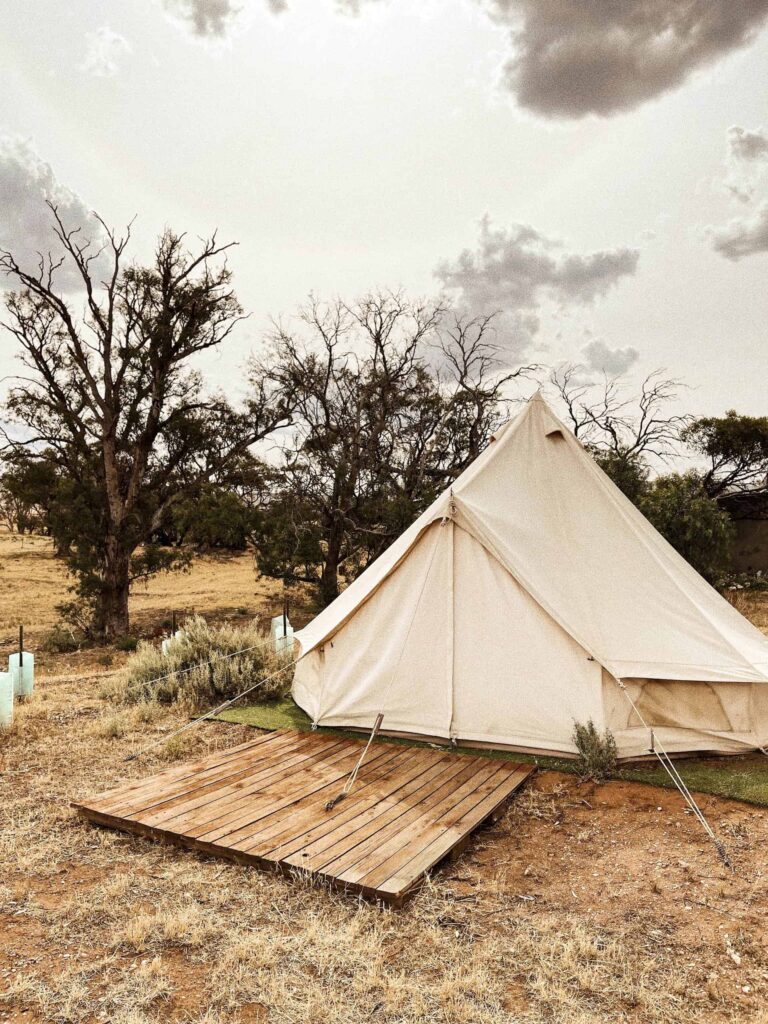
- Ideal for: groups
- Best location: festival and events
A canopy tent is a shelter with open sides, usually used to provide shelter during events such as BBQs and festivals.
You can’t camp in a canopy tent, but they come in handy for keeping gear undercover and providing a place to sit if the weather takes a turn. Bear in mind that they can get torn down quite easily by storms, so you’ll need to be quick at bringing them down if the weather gets too bad.
Canopy tents come in all sizes, they’re easy to set up and fairly small, so they’re ideal as an extra for camping trips.
However, if you’re going backpacking, they add unnecessary bulk to your pack, so I’d forgo a canopy.
Beach tents
- Ideal for: families
- Best location: the beach
A beach tent is a three-sided shelter that offers protection from harmful UV rays. They’re called “beach” tents because they’re perfect for taking to the beach, but they’re also useful for the garden, festivals, and campsites.
Most families get one of these if they have small kids who need extra protection from the sun. They have enough space for little ones to play while providing enough shade to keep them safe.
You can’t camp in a beach tent, but they’re a useful extra to take on trips to sunny spots – like the Great Sand Dunes National Park.
Ridge tents

- Ideal for: couples or small groups
- Best location: fixed campsite
A ridge tent looks like an A-frame when it’s pitched, and it’s a popular choice because of its design. Originally, ridge tents were made of canvas and had metal poles, so they were incredibly heavy.
Now, ridge tents are much more lightweight and easy to erect. They have good head height, but they’re fairly compact, so they are best for couples or small groups.
They do become very heavy when packed, so they’re not ideal for backpacking or hiking. Instead, choose an A-frame tent for a fixed camping trip.
Tipi tents

- Ideal for: individuals or couples
- Best location: fixed campsite or backpacking
A tipi tent has a wide base and tapered top, inspired by the original tipi tents used by Native American Nomadic hunters.
The design gives plenty of head height in the center of the tent, with a lot of storage space around the edges. However, this design also makes the tent rather compact, so it’s best for individuals or couples.
Modern tipi tents are lightweight and easily fit in a backpack, so they’re a good choice for hiking and backpacking. The shape also makes them incredibly wind and weather-resistant.
You’ll struggle to get more than one or two sleeping mats in a tipi comfortably, so you’ll need multiple if you like this shape for a family trip.
Bell tents

- Ideal for: groups or families
- Best location: fixed campsite or glamping
When you think of glamping tents, you’re probably picturing a bell tent. They usually have a canvas exterior and a single central pole, making them look like mini circus tents.
It’s one of the most spacious options when it comes to tents, making them comfy and homey. If you’re going on a camping trip and want to take a lot of amenities, a bell tent gives plenty of space.
The downside is the weight. Bell tents are heavy, so you’ll need plenty of space in your vehicle to take one to a campground. They also take time to set up and will need multiple people to do it right.
Bivy tents
- Ideal for: individuals
- Best location: wildnerness
Bivvy tents are emergency shelters used for backpacking and survival camping. They are small and narrow, only fit one person, and are ideal for backpackers looking to save space on gear.
Unlike a normal tent, a bivvy tent doesn’t have much room for your gear, so you’ll need a waterproof covering to keep your equipment dry. However, if you’re going wild camping, a bivvy tent could be ideal.
Geodesic or semi-geodesic tents
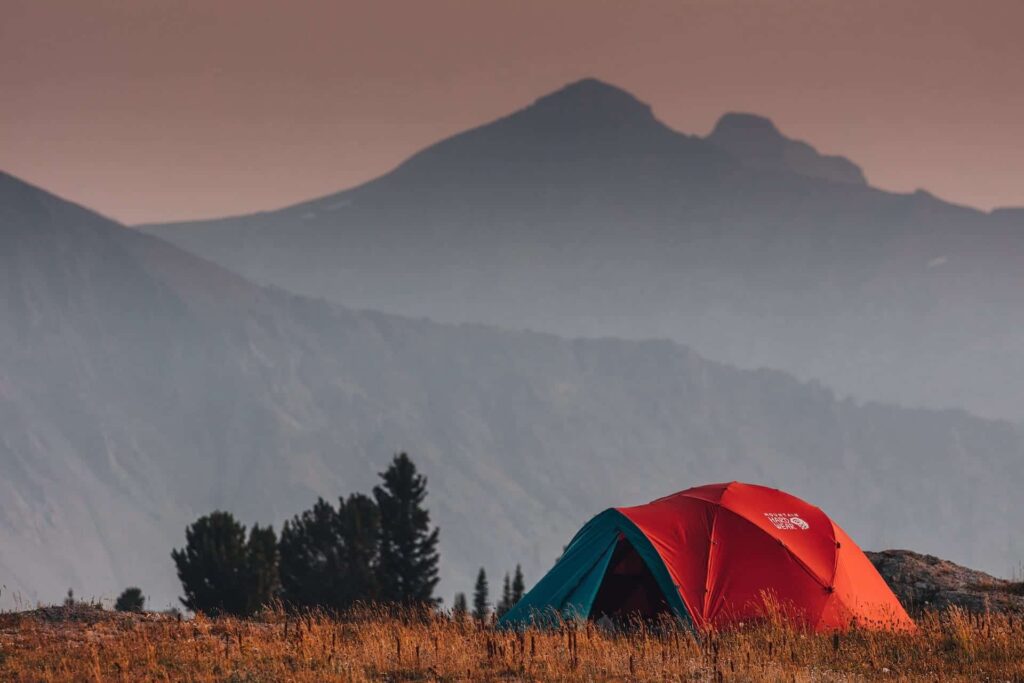
- Ideal for: individuals or couples
- Best location: wildnerness
A geodesic tent is built to withstand extreme weather conditions. If you’re going mountaineering or hiking and need a tent large enough for two people, a geodesic tent is your best bet.
Geodesic tents have multiple poles that cross over each other for added stability and are usually large enough for two people.
Since they are a higher quality tent, they are priced higher. But the price is worth it if you know you’ll be facing tough weather conditions.
Pyramid tents
- Ideal for: individuals or couples
- Best location: backpacking
A pyramid tent is similar to a tipi with a wide base and tapered top. The main difference is the height – tipis tend to be much taller than pyramid tents.
These are extremely lightweight and weather resistant, so they are great for backpacking. You can even get ultralightweight single-person pyramid tents if you plan on going minimalist camping.
The downside is the lack of space. Most pyramid tents have storage around the edges, but they are a little compact for camping.
Single-pole tents are also less strong than other options, so setting up with proper guide ropes is key.
Cabin tents

- Ideal for: families or groups
- Best location: campgrounds
A cabin tent is ideal for affordable family camping. They have a square cabin shape with plenty of room inside for multiple camp beds and gear.
The walls are usually canvas or polyester, making them weather-resistant, but they do struggle in storms due to their wide footprint.
They are also incredibly bulky and heavy to transport, so these are not suitable for hiking or backpacking.
Backpacking tents
- Ideal for: individuals or couples
- Best location: backpacking
As the name suggests, this type of camping tent is designed for backpackers. They are lightweight, compact, and can easily fit in a pack.
They usually have a geodesic or tunnel shape, which is weather resistant and easy to erect. However, there is usually only space for one or two people at most, so they’re not great for groups.
If you’re planning a multi-day trip with a lot of hiking involved, you need a backpacking tent.
Multi-room tents

- Ideal for: families and groups
- Best location: campgrounds
A multi-room tent is sectioned off to give separate living and sleeping areas. For families and groups looking to share a tent, this is ideal. You’ll get your own bedroom and enough space to keep your stuff.
Although cabin tents give more space, it can be tough sleeping in the same room as family or friends. A multi-room tent is a good solution.
It’s also a great option for families with kids who need to go to bed early or take afternoon naps. Many multi-room tents have blackout rooms which make them much more comfortable to sleep in during the early morning and daytime.
Multi-room tents come in different sizes and can be quite heavy. If you’re going to a campsite, these are ideal. However, they are too heavy for backpacking.
Suspended tents
- Ideal for: individuals or couples
- Best location: wilderness
If you’re going backpacking and don’t want to sleep on the ground, a suspended tent is a great option. Once set up, they are far more comfortable than traditional ground tents and stop your tent from getting wet or muddy.
It’s also great fun sleeping in a hammock tent and is a great change of pace if you go backpacking often.
The catch is the setup. It can be tough finding an appropriate spot to suspend a tent, and it takes a little practice getting it right. Getting in for the first time can also feel a little daunting, but you’ll soon relax into the weightless feeling.
However, they offer better protection from bugs, flooding, and animals if you’re out in the wilderness.
Dome tents
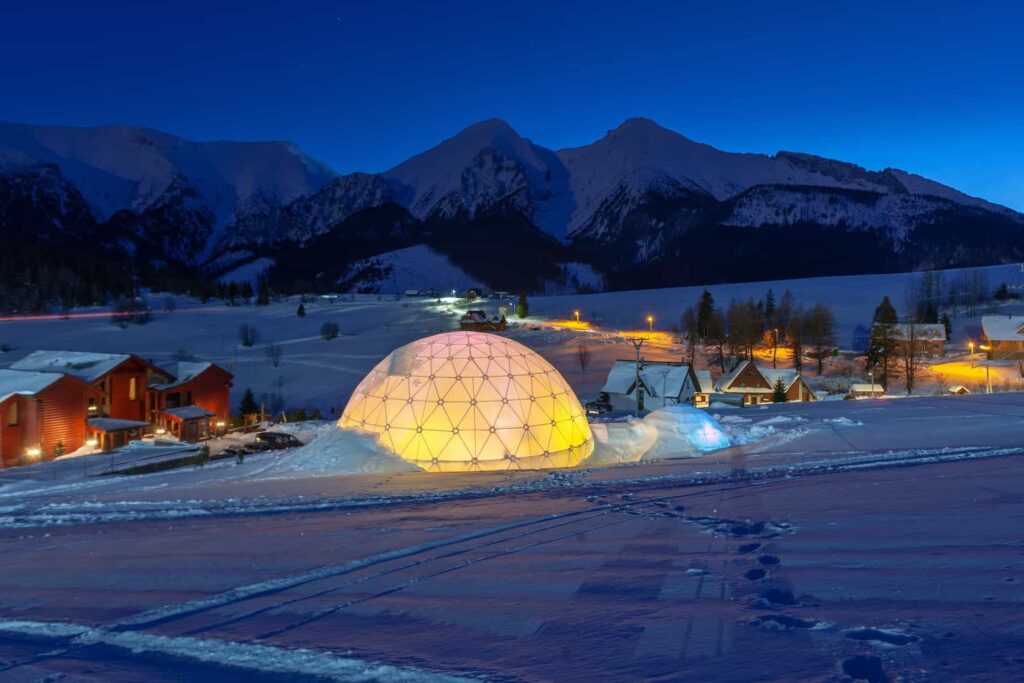
- Ideal for: individuals, couples, or groups
- Best location: campgrounds
This is the most common type of tent and one you’ve probably seen the most often. They have a dome shape and a semi-circle entrance on the front. Dome tents have two poles that cross over the top to give good support and semi-decent head height.
Dome tents come in a range of sizes to accommodate individuals, couples, or groups of up to eight people. They are lighter than other larger options and have enough room for basic supplies.
If you’re looking for a decent tent for a camping trip, a dome tent is always a safe option. They are a little heavy for backpacking, but they’re a great option for fixed camping at a campsite or event.
Which type of camping tent is right for you?
When it comes to choosing the right tent for your trip, focus on three variables: your location, the potential weather, and who you’re going with.
If you find a tent that fits those three criteria, you can’t go far wrong in choosing the best camping tent.
If you haven’t decided what kind of camping trip you want to go on yet, did you know you have twelve options to choose from? Check them all out in our next guide on the different types of camping.

